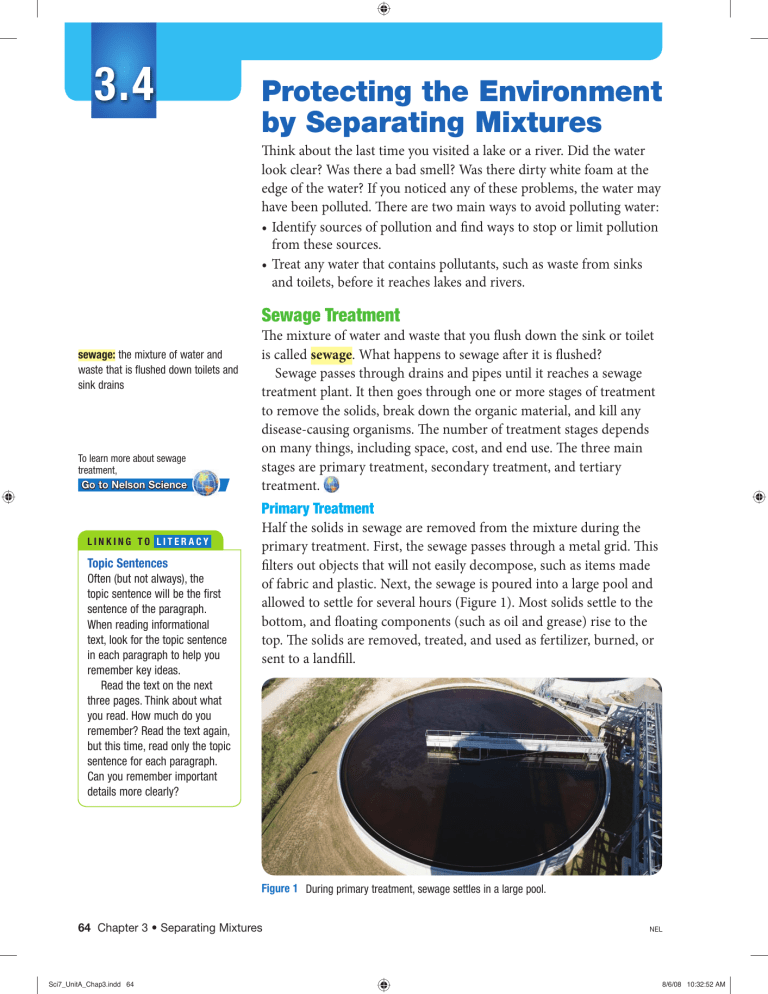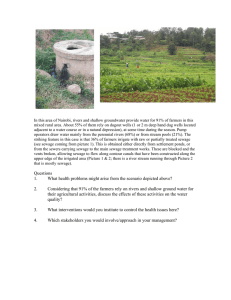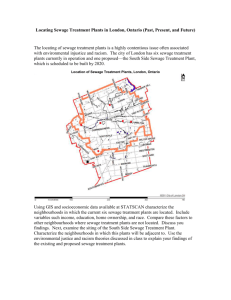
3.4 Protecting the Environment by Separating Mixtures Think about the last time you visited a lake or a river. Did the water look clear? Was there a bad smell? Was there dirty white foam at the edge of the water? If you noticed any of these problems, the water may have been polluted. There are two main ways to avoid polluting water: • Identify sources of pollution and find ways to stop or limit pollution from these sources. • Treat any water that contains pollutants, such as waste from sinks and toilets, before it reaches lakes and rivers. Sewage Treatment sewage: the mixture of water and waste that is flushed down toilets and sink drains To learn more about sewage treatment, Go to Nelson Science LINKING TO LITERACY Topic Sentences Often (but not always), the topic sentence will be the first sentence of the paragraph. When reading informational text, look for the topic sentence in each paragraph to help you remember key ideas. Read the text on the next three pages. Think about what you read. How much do you remember? Read the text again, but this time, read only the topic sentence for each paragraph. Can you remember important details more clearly? The mixture of water and waste that you flush down the sink or toilet is called sewage. What happens to sewage after it is flushed? Sewage passes through drains and pipes until it reaches a sewage treatment plant. It then goes through one or more stages of treatment to remove the solids, break down the organic material, and kill any disease-causing organisms. The number of treatment stages depends on many things, including space, cost, and end use. The three main stages are primary treatment, secondary treatment, and tertiary treatment. Primary Treatment Half the solids in sewage are removed from the mixture during the primary treatment. First, the sewage passes through a metal grid. This filters out objects that will not easily decompose, such as items made of fabric and plastic. Next, the sewage is poured into a large pool and allowed to settle for several hours (Figure 1). Most solids settle to the bottom, and floating components (such as oil and grease) rise to the top. The solids are removed, treated, and used as fertilizer, burned, or sent to a landfill. Figure 1 During primary treatment, sewage settles in a large pool. 64 Chapter 3 • Separating Mixtures Sci7_UnitA_Chap3.indd 64 NEL 8/6/08 10:32:52 AM Secondary Treatment The remaining dirty water passes through tanks containing bacteria during the secondary treatment. Oxygen gas is bubbled through the mixture (Figure 2). The bacteria break down any remaining human waste and plant material. Next, the water is allowed to settle again. The bacteria settle to the bottom and are removed. Figure 2 During secondary treatment, bacteria remove any wastes left in the liquid mixture. Tertiary Treatment Pollutants like phosphorus and nitrogen are removed during the tertiary treatment (Figure 3). Various kinds of bacteria are encouraged to grow in the wastewater. The water may also pass through filters, have ozone bubbled through it, or be exposed to ultraviolet radiation. Finally, chlorine is added to the water to kill any remaining organisms. Now the water is clean enough to be returned to the ocean, lake, or river. Figure 3 During some tertiary treatments, chemicals are added to the water. The water may also be filtered. NEL Sci7_UnitA_Chap3.indd 65 3.4 Protecting the Environment by Separating Mixtures 65 8/6/08 10:33:02 AM Figure 4 Once a bird’s feathers are coated in oil, the bird quickly loses body heat and dies. To learn more about oil spill cleanup, Go to Nelson Science Keeping Our Water Clean As you learned in Section 2.1, polluted water is a mixture of contaminants and pure water. Besides sewage, the contaminants can get into water from • waste produced by manufacturing or processing factories • fertilizers, pesticides, or salt from farms, golf courses, or roads • accidental spills and leaks Clean water is important to everyone, and we must work together to keep pollutants out of the water. Mixtures of dirty water can be very difficult to separate. Petroleum and petroleum products are transported on ships around the world, including around the Great Lakes. If an oil-carrying cargo ship leaks or sinks, the oil escapes into the ocean or lake water. Some of the substances in oil sink and contaminate the lake or sea bed. Other parts float and spread over the surface, affecting the wildlife that live on or near the water (Figure 4). It is very difficult to separate oil from water once they are mixed. Oil spill clean-up operations are timeconsuming, costly, and usually only partly successful. TRY THIS: Clean Up an Oil Spill SKILLS MENU: planning, performing, evaluating, communicating In this activity, you will plan and investigate different methods of removing oil from water. Equipment and Materials: apron; shallow container; spoon; medicine dropper; water; cooking oil; paper plate; cotton balls; straws; detergent; other materials of your choice 1. Put on your apron. Run water into the container until it is a few centimetres deep. 2. Pour a small amount of oil on the water. Wait until the oil spreads over the water, and then pour another small amount. Keep pouring until about half the water is covered with a thin layer of oil. 3. Use the spoon, cotton balls, medicine dropper, straws, detergent, and any other material you choose to clean up the “oil spill.” Try at least three different methods. For example: • • • • Use the cotton balls or paper towels to soak up the oil. Use the medicine dropper to suck up oil. Use the straws to move the oil to one corner. Add drops of detergent to the oil. A. Which method was the most successful? Why? B. Do you think this method could be used to clean up a real oil spill? Explain your answer. C. Research ways of cleaning up an oil spill on the ocean. Are any of these ways similar to what you did in this activity? Explain how. Unit Task As you work on the Unit Task, you will have to think about the environmental considerations that were mentioned in this section. CHECK YOUR LEARNING 1. What are the two main ways to avoid water pollution? 2. How is settling used in sewage treatment? 3. Briefly outline the main steps of the sewage treatment process. 4. List some ways in which pollutants can get into water. 66 Chapter 3 • Separating Mixtures Sci7_UnitA_Chap3.indd 66 5. Why is it particularly difficult to separate oil and water once they are mixed? 6. Give at least one example of how oil spills can endanger wildlife. NEL 8/6/08 11:35:33 AM




